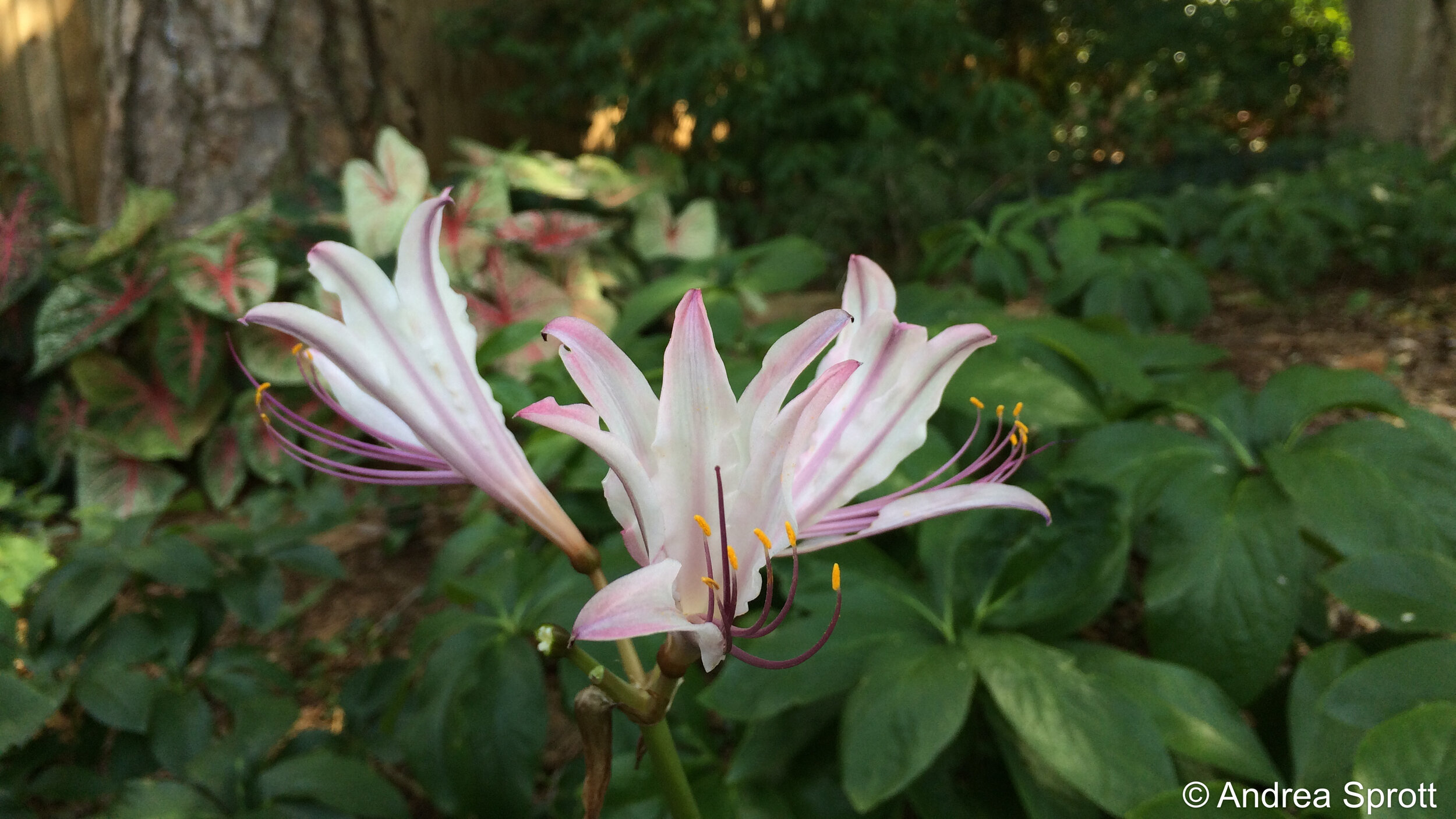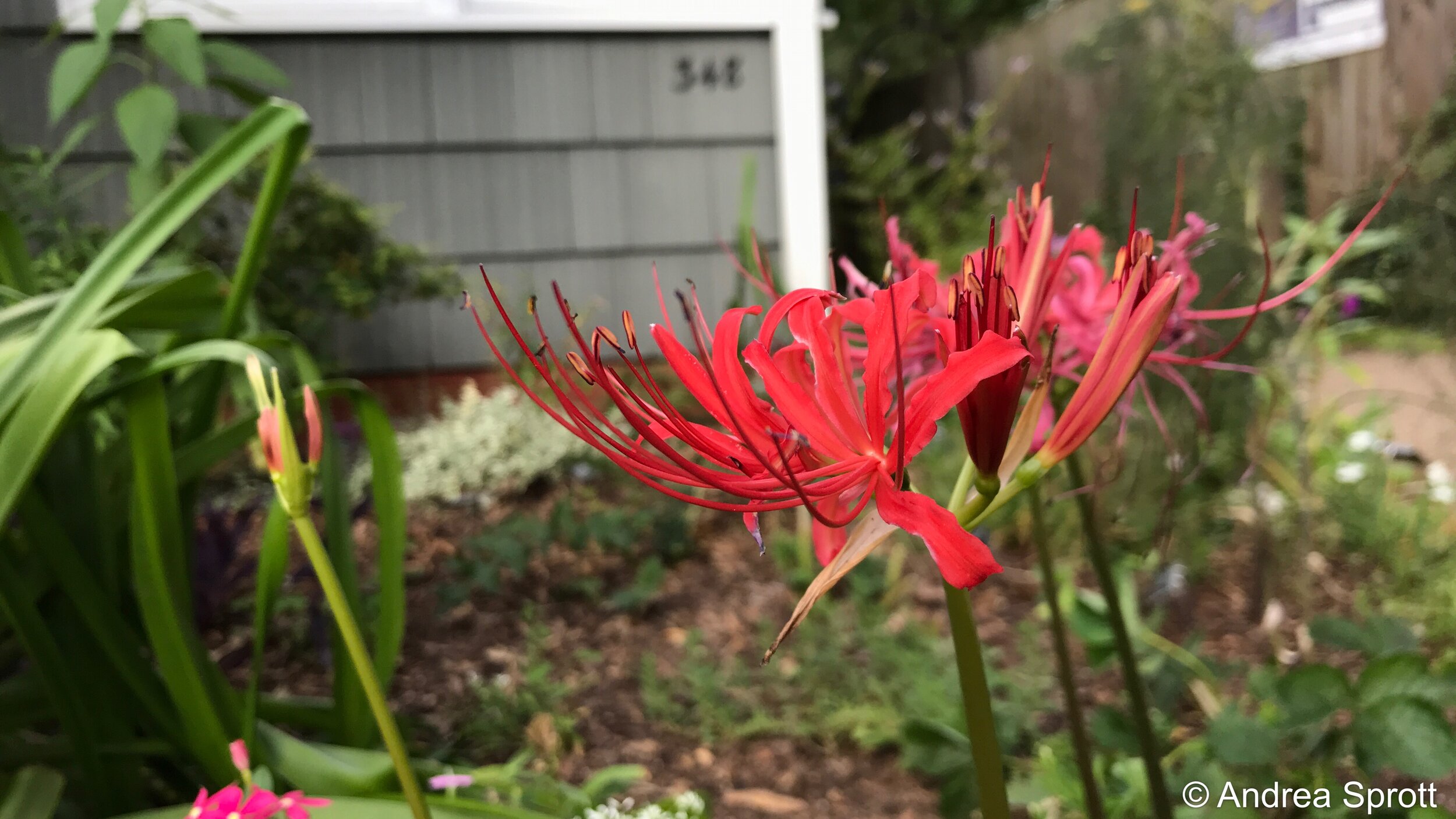~ From July to August ~
There are few flowers that I long more to see each year than those of lycoris. There is something bewitching about these bulbs. Perhaps it is the way they spring from the ground seemingly overnight; perhaps it is their brief but spectacular flowering. The anticipation is like a siren that lures me in more every year.
I started writing this post about all of the types of lycoris in Elizabeth Lawrence’s garden, but it got to be too long… even I nearly tired of reading it. So, in order to save us all from bewitching bulb burnout, I’m splitting the post in two. Elizabeth Lawrence grew several types of Lycoris during her 35 years here, a handful of which remain. The ones that are still here, however, are numerous, especially Lycoris albiflora, but you’ll read more about these in “Lovely Lycoris, the Bewitching Bulbs, part 2”.
In this segment I’ll be taking you on a tour of the first four types of lycoris to bloom in the garden... these span July and August. In the next segment, you will get the next four to bloom… those that span August and September. Now then… onward and upward to the lovely lycoris!

Lycoris squmaigera, the pink surprise lily, begins the season of lycoris bloom in this garden. Elizabeth planted and divided so many over the years that she wrote her garden was filled with pink when they bloomed. Today, there are only three clumps of which I know that remain. The largest of these Elizabeth cleverly planted behind her Crinum ‘Cecil Houdyshel’, which almost finishes its bloom cycle when the 3’ tall pink surprise lily begins. The color of both is nearly identical—a pale and luminous pink. (This type of color echo/succession planting is brilliant; Elizabeth was a master at it. It seems so simple, but it is not so easily accomplished.)
Next to bloom, usually arriving early in August, is the somewhat smaller—but no less exciting—Lycoris incarnata, the peppermint surprise lily. Of two plantings here, I am certain one is original: a grouping in the back of the garden (what Elizabeth called “the woods”). It popped up out of nowhere (surprise!) in 2014, after decades of dormancy. (Yes, I said decades.) I can only attribute its sudden reappearance to my merciless editing of the thicket of Helleborus orientalis (more correctly H. x hybridus) that blanketed the area. According to Elizabeth’s index card, she planted this lycoris in 1952, long before the Lenten roses had a chance to nearly choke it out.


From 2014 to 2018, this striped surprise lily bloomed every year, and each year it increased. I waited anxiously for its arrival in 2019… nothing. Foliage emerged later, as per usual... that was a good sign; at least the bulbs weren’t gone. Lycoris can be temperamental bloomers, so I hoped it was just taking a gap year. The next year, I awaited their return… again, no bloom. The same thing happened this year… nada. Looking back at my notes, I think I know what the problem is: I accidentally dug the bulbs out in late 2018 and replanted them. While that alone shouldn’t be problematic, what would be bad is if I planted them too deeply, which I’m almost certain I did. As I was reading some of Elizabeth’s writings about lycoris, I came across many references to shallow planting being a must for them to bloom well. Well, nuts! Now I must disturb them again; this time I will make sure they are planted properly. Come next August, you may well find me parked in the back of the garden, staring intently at the ground, awaiting signs of life. We gardeners are a hopeful bunch.
A new addition to the collection, Lycoris shaanxiensis is a stunner.
I found Lycoris shaanxiensis available from Arrowhead Alpines in early 2019. I planted it, fully expecting it would be at least a year before it would bloom. Nope! The second week of August brought one 14” stalk of narrow-petaled, crisped pale yellow blooms with just a hint of maroon in the keel. Last year two stalks emerged, once again the second week in August. This year brought five stalks! I am impressed with this type so far.
Blooming about the same time is an early form of L. radiata that came to Elizabeth Lawrence from Sam Caldwell, a lycoris aficionado from the Nashville, Tennessee area. He called it “fertile—Georgia strain,” and that is what is on its plant identification tag in the garden. Elizabeth planted it November 9, 1970 in front of her house, where it remains to this day. It is the only fertile form of lycoris in the garden, and although I have never found seedlings, seeds do germinate when sown purposefully.
Having this early form makes the season of red spider lily seem to be nearly two months because Elizabeth was (once again) clever and planted the later blooming type nearby.


Red spider-lilies are better known than most of the fall-blooming amaryllids, but there are others of importance to gardeners in the South. Their beauty and variety turn the last season of the year into a second and more brilliant spring.”
No one could say it any better than that passage from A Southern Garden. Thank you, Elizabeth Lawrence!



